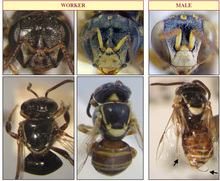
Bees are insects with wings closely related to wasps and ants, known for their role in pollination and, in the case of the best-known bee species, the western honey bee, for producing honey. Bees are a monophyletic lineage within the superfamily Apoidea. They are presently considered a clade, called Anthophila. There are over 16,000 known species of bees in seven recognized biological families. Some species – including honey bees, bumblebees, and stingless bees – live socially in colonies while most species (>90%) – including mason bees, carpenter bees, leafcutter bees, and sweat bees – are solitary.

Stingless bees, sometimes called stingless honey bees or simply meliponines, are a large group of bees, comprising the tribe Meliponini. They belong in the family Apidae, and are closely related to common honey bees, carpenter bees, orchid bees, and bumblebees. Meliponines have stingers, but they are highly reduced and cannot be used for defense, though these bees exhibit other defensive behaviors and mechanisms. Meliponines are not the only type of "stingless" bee; all male bees and many female bees of several other families, such as Andrenidae, also cannot sting. Some stingless bees have painful and powerful bites.

Schwarziana quadripunctata is a small, stingless bee found in a stretch of the South American Amazon from Goiás, Brazil, through Paraguay, to Misiones, Argentina. This highly eusocial insect constructs earthen nests in the subterranean level of the subtropical environment, an unusual feature among other stingless bees. The species ranges in sizes from 6.0 to 7.5 millimetres and feeds on a diverse diet of flowering plants found abundantly on the forest floor, including guacatonga and the mistletoe species Struthanthus concinnus.

Allodapula is a genus of bees in the family Apidae, subfamily Xylocopinae. They are similar in appearance, around 7mm in length, with swarthy head and thorax, contrasting with the brown abdomen. After the removal of a number of former species into other genera, the genus as presently defined occurs only in Africa.

Tetragonula carbonaria is a stingless bee, endemic to the north-east coast of Australia. Its common name is sugarbag bee. They are also occasionally referred to as bush bees. The bee is known to pollinate orchid species, such as Dendrobium lichenastrum, D. toressae, and D. speciosum. It has been identified as an insect that collects pollen from the cycad Cycas media. They are also known for their small body size, reduced wing venation, and highly developed social structure comparable to honey bees.

Tetragonisca angustula is a small eusocial stingless bee found in México, Central and South America. It is known by a variety of names in different regions. A subspecies, Tetragonisca angustula fiebrigi, occupies different areas in South America and has a slightly different coloration.
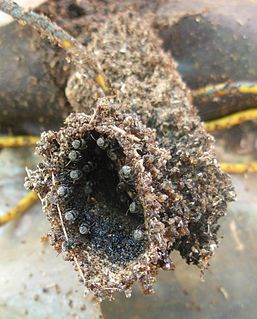
The Indian stingless bee or dammar bee, Tetragonula iridipennis, is a species of bee belonging to the family Apidae, subfamily Apinae. It was first described by Frederick Smith in 1854 who found the species in what is now the island of Sri Lanka. Many older references erroneously placed this species in Melipona, an unrelated genus from the New World, and until recently it was placed in Trigona, therefore still often mistakenly referred to as Trigona iridipennis. For centuries, colonies of T. iridipennis have been kept in objects such as clay pots so that their highly prized medicinal honey can be utilized.

Melipona beecheii is a species of eusocial stingless bee. It is native to Central America from the Yucatán Peninsula in the north to Costa Rica in the south. M. beecheii was cultivated in the Yucatán Peninsula starting in the pre-Columbian era by the ancient Maya civilization. The Mayan name for M. beecheii is xunan kab, which translates roughly to "regal lady bee". M. beecheii once served as the subject of various Mayan religious ceremonies.

Trigona corvina is a species of stingless bee that lives primarily in Central and South America. In Panama, they are sometimes known as zagañas. They live in protective nests high in the trees, but they can be extremely aggressive and territorial over their resources. They use their pheromones to protect their food sources and to signal their location to nest mates. This black stingless bees of the tribe Meliponini can be parasitic toward citrus trees but also helpful for crop pollination.
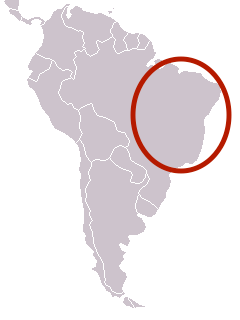
Nannotrigona testaceicornis is a eusocial stingless bee species of the order Hymenoptera and the genus Nannotrigona. Its local common name is abelhas iraí. This species has a large geographic distribution and occupies different biomes, including urban areas, around Neotropical America. The bees of this species nest in trees or artificial cavities because of this broad distribution. N. testaceicornis is important for agriculture because it will pollinate a vast number of plant species year round.

Melipona quadrifasciata is a species of eusocial, stingless bee of the order Hymenoptera. It is native to the southeastern coastal states of Brazil, where it is more commonly known as mandaçaia, which means "beautiful guard," as there is always a bee at the narrow entrance of the nest. M. quadrifasciata constructs mud hives in the hollows of trees to create thin passages that only allow one bee to pass at a time. Because they are stingless bees, M. quadrifasciata is often used as pollinators in greenhouses, outperforming honey bees in efficiency and leading to overall larger yields of fruits that were heavier, larger, and contained more seeds.

Tetragonula hockingsi is a small stingless bee native to Australia. It is found primarily in Queensland. The colonies can get quite large, with up to 10,000 workers and a single queen. Workers of Tetragonula hockingsi have been observed in fatal fights with other Tetragonula species, where the worker bees risk their lives for the potential benefit of scarce resources.
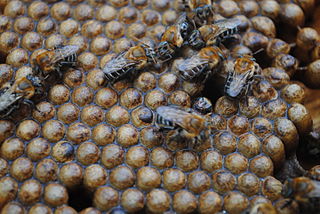
Melipona scutellaris is a eusocial stingless bee species of the order Hymenoptera and the genus Melipona. It is considered to be the reared Melipona species with the largest distribution in the North and Northeast regions of Brazil, with records from Rio Grande do Norte down to Bahia. Its common name, Uruçu, comes from the Tupi "eiru su", which in this indigenous language means "big bee". Their honey is highly desirable and the materials they create for nests have been proven to be a promising source of antibiofilm agents and to present selectivity against human cancer cell lines at low concentrations compared to normal cells.
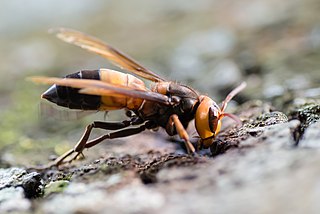
Vespa soror is a species of hornet present in India, Northern Thailand, Laos, Northern Vietnam, and parts of South China, including Hong Kong, Guangdong, Fujian, and Hainan Island.
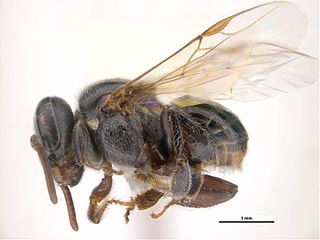
Austroplebeia is a stingless bee (Meliponini) genus in the family Apidae. The genus was erected by Jesus Santiago Moure in 1961. The genus comprises five described species endemic to Australia and New Guinea.Austroplebeia are more closed related to the African stingless bees than rest of the species found in Asia and Australia.

Austroplebeia australis is a stingless bee species in the tribe Meliponini first validly described by Heinrich Friese in 1898. Within Australia, they are occasionally referred to as bush bees.
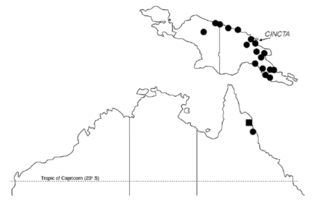
Austroplebeia cincta is a small eusocial stingless bee first described by Mocsáry in 1898 and it is found across Australia and Papua New Guinea.

Austroplebeia cassiae is a small eusocial stingless bee first described by Cockerell in 1910 and it is found in Australia.
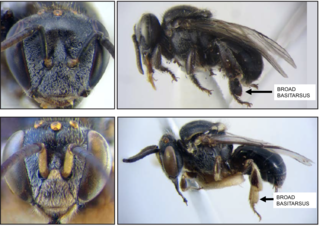
Austroplebeia magna is a small eusocial stingless bee first described by Dollin, Dollin and Rasmussen in 2015 and it is found in Australia.

Tetragonula mellipes is a small eusocial stingless bee first described by Friese in 1898 and it is found in Northern Australia.
